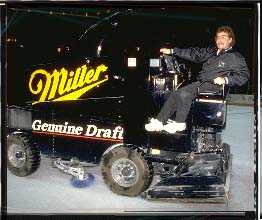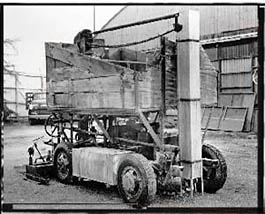|
Making ice
So how do you make ice? Ice makers were hard at work long
before Professor Somorjai's research was published. Most of their knowledge
about ice comes from trial and error, not from scientific journals and textbooks.
In our conversation with San Jose Arena ice maker Bruce Tharaldson, we learned
a great deal about ice. In addition, we got a chance to see and better understand
the legendary ice resurfacer--the Zamboni.
|

|
Ice maker Bruce Tharaldson drives one of the two Zambonis at the San Jose
Arena.
|
|
|

|
Bruce Tharaldson talks about the process involved
in making ice at the beginning of the season.
|
|
Bruce Tharaldson has been involved in the "ice business"
for over 20 seasons, starting out making ice for the Minnesota North Stars
(now the Dallas Stars). Bruce is responsible for constructing and maintaining
the Sharks' playing surface throughout the 82-game season. The season begins
in early October and ends in April. The playoffs can extend the season into
May or even June.
|
|
At the beginning of the hockey season, the arena uses an advanced
refrigeration system that pumps freezing "brinewater" (salt water)
through a system of pipes that run through a large piece of concrete known
as the "ice slab." When the "ice slab" gets cold enough,
layers of water are applied to it. The first few layers are painted with
the hockey markings and the advertisements that you see on (or more correctly
"in") the ice. These layers are then covered with 8 to 10 more
thin layers of ice. When complete, the ice is only one inch thick! The ice
stays in place from September to May. The NBA's Golden State Warriors played
on a basketball court that sits on top of the ice. When world famous tenor
Luciano Pavarotti visits the San Jose Arena, he sings on a stage above 10,211
gallons (38,652 litres) of frozen water.
|
|

|
The Zamboni Legend
Once the ice is made, the ongoing task of maintaining the
quality of the ice becomes Bruce Tharaldson's primary focus. One of the
essential tools for helping maintain the ice is the Zamboni. This mechanical marvel was first built
in the early 1940s in southern California (of all places). Frank Zamboni and his brother Lawrence
needed a more efficient way to resurface their large ice rink, "Iceland." Up to that time, one would
have to drag a scraper behind a tractor to smooth the surface and then go back and coat the ice with
a thin layer of water to even things out and rebuild the thickness of the ice. This process could
take over one hour! Frank Zamboni, an inexaustable inventor, made the process much quicker with
his newly invented "Zamboni ice resurfacer."
|
|
The Zamboni is a mechanical ice resurfacer. It works by
scraping the ice surface and collecting the snow (which is later discarded).
Next, it "cleans" the ice, by putting down water which flushes
the grooves deep in the ice, loosening any dirt or debris. The excess water
and dirt is then collected. Finally, the Zamboni puts down a thin layer
of heated water--which freezes and creates a smooth surface. The heated
water, according to Tharaldson, is about 140 to 145 degrees Fahrenheit (60-63
centigrade); "the hotter the water," he says, "the more even
a surface you'll get--it melts that top layer when you cut across [the ice]."
Click the "forward"
button below to continue.
|
|